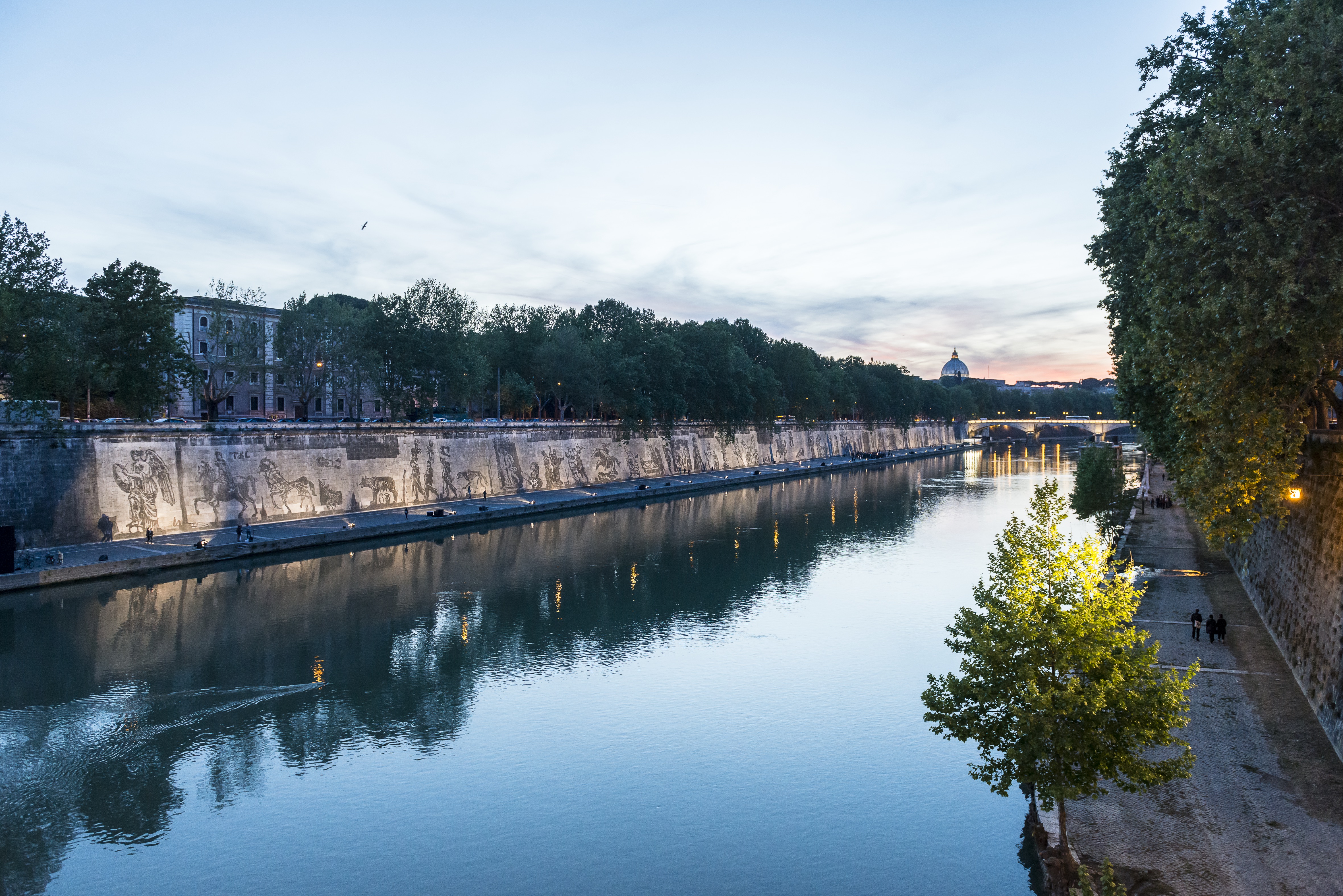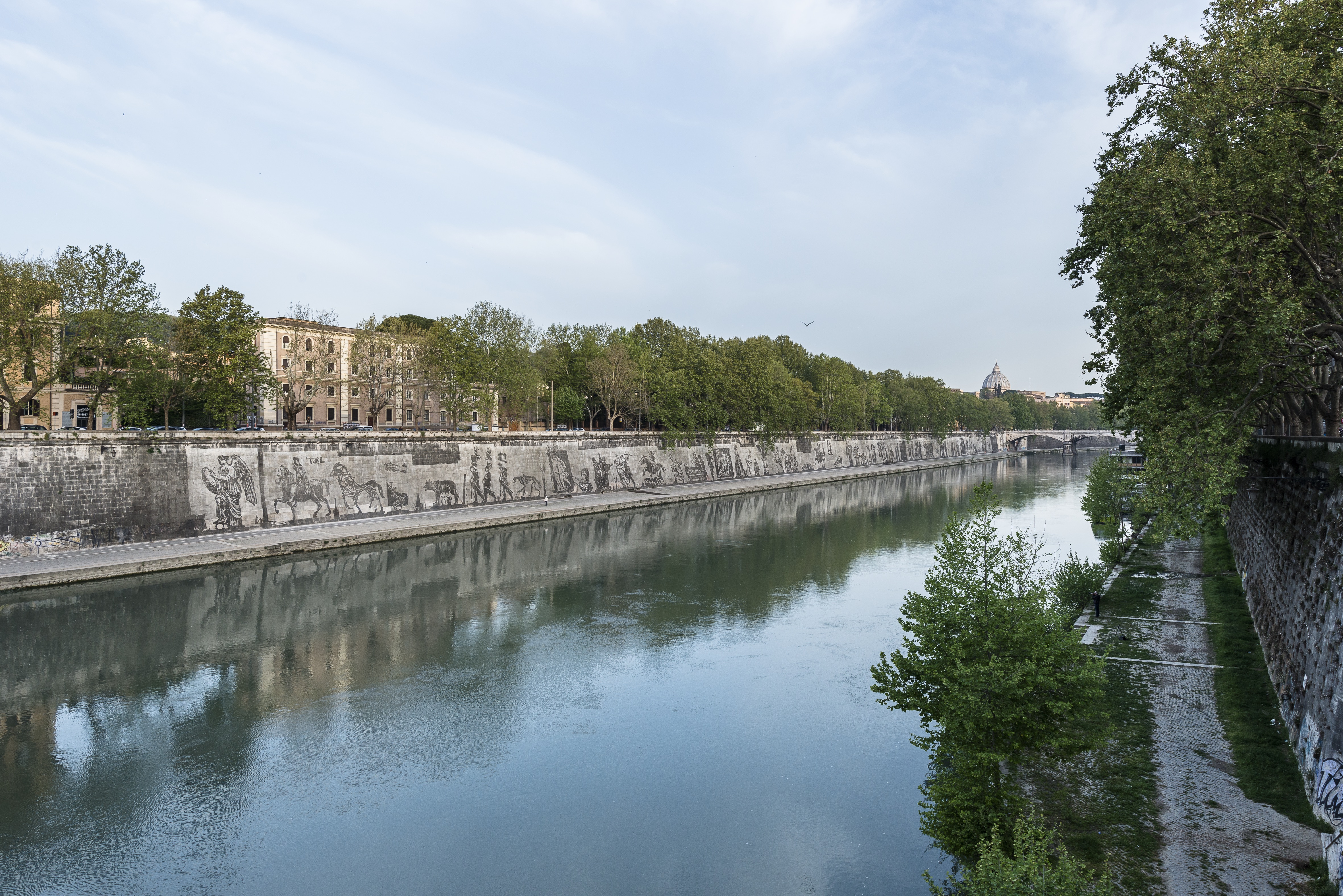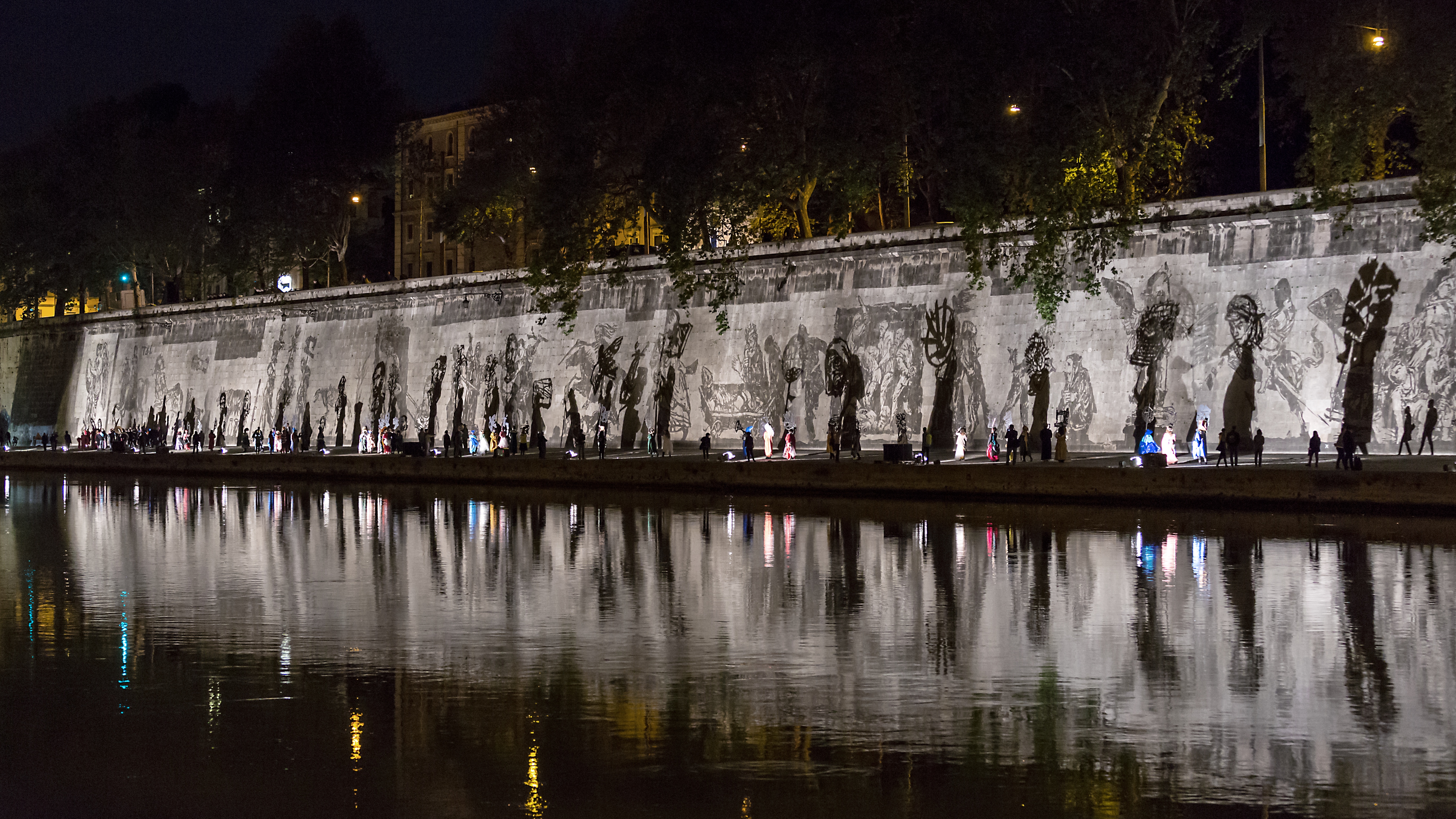
William Kentridge. Triumphs and Laments. Bridge at dusk, details of the frieze. 500 x 10 meters. Photo by Sebastiano Luciano.
“Every victory has a [corresponding] defeat; therefore, for every person riding in triumph, there will always be someone following behind with a lament.”1 This is how William Kentridge discloses the meaning of Triumphs and Laments, his 500-meter-long frieze created on the banks of the Tiber River. The procession of ninety figures, stenciled on the walls between Ponte Sisto and Ponte Mazzini, was created by removing portions of the grime that has accumulated on the travertine over the centuries.
While responding to the extraordinary richness of the history of Rome, this work also meditates on the concept of history. It is not a linear tale of triumphal moments but rather a flow of victorious and defeated figures; it is not a collection of past events permanently carved on the city’s walls but rather a transient drawing that emerges from the stone and will, with time, fade away. “The images are there,” says Kentridge, “but over several years, they will gradually vanish back into the rocks…as part of an understanding of history as provisional, of triumphs being there but disappearing, of fears as having their moments but then collapsing, and also of tears coming to an end.”
Maria Pia Masella: How did it feel to draw historical Roman figures in the studio while thinking that Rome itself would be the background?
William Kentridge: Well, for the first several years I thought that this project was not going to be in Rome. I wanted to do large-scale drawings of Rome, but it seemed very unlikely that we would get the permission and the money. I thought that it would be a project that would exist on paper only. That made it easier to draw the figures because I did not have the responsibility of having the work be in the world. Also, I knew that the project could not try to be a history lesson; it could not try to be didactic. It had to be images and characters and parts of history that interested me.
MPM: You chose to refer directly to figures and groups that are part of the history of Rome, some of which are in the Arch of Titus and in Trajan’s Column. Is there a reason why you chose those two monuments in particular?
WK: Trajan’s Column is in the form of a frieze wound in a spiral around the column, but it also is an image of people on the move; they are all moving in a direction. So, to achieve the idea of a frieze, I needed a sense of the people moving along the wall, not just statues standing along it, and it was helpful to refer to an artwork that had this. I also decided that I wanted all the images to have a recognizable relationship to images from Italian or Roman history rather than just be invented images. There were other drawings that I did on my own—refugees, people walking—but in the end they were replaced by more specific images.
MPM: Triumphs and Laments has been described as a dynamic, cinematographic frieze, with figures creating a sequence within a continuum, yet each of them carries its own context and its own time.
WK: It is a question of punctuation and rhythm. If one has 500 meters, one can either place the figures equally—a total of 120 figures, with one figure every four meters—or one can place them in groups. Sometimes there are natural groupings—people with a chariot and horses and a charioteer—and sometimes there are historical leaps of connection, of putting together groups of things. For example, the taking of the loot from Jerusalem in 70 BCE (from the Arch of Titus) is put together with images of Jews in the ghetto from the seventeenth century. So those connections are made and then can jump out of time. To make this big rubbish pile of history in the middle, with the beheading of the barbarians (from Trajan’s Column) placed together with the body of Aldo Moro in his Renault, together with an image of The Ecstasy of Saint Theresa by Bernini—to see if, in smashing these different bits of history together, each one makes you see the others more clearly.
MPM: Is this project a deliberate break with the linear transmission of the past, which one finds in traditional friezes?
WK: Yes, Triumphs and Laments had to bring the classical and even the pre-classical and the antique into the present. This is done by placing the image of Remus killed by Romulus (from a Renaissance engraving made fifteen hundred years later than the original story) together with the photo of Pasolini found dead on the street. There is a similarity between the two images and, by putting them together, one gets an immediate sense of the violent deaths of the men, rather than one existing only in myth and the other in modern life.
MPM: The processions’ sense of violence and death has been a part of your work since the 1990s. How did processions begin to populate your work?
WK: The processions began with my early theatrical work: a production of Büchner’s play Woyzeck and the moving shadow figures. It began with that and an understanding that one can create all the different shadow figures and then make them visible at the same time in the long form of a frieze. The procession was a good way to convey a sense of the mass and the range of people. Of course, the shadow figures also refer to the shadows in the cave of Plato.
MPM: Are your shadows on a journey traveling toward the discovery of the truth?
WK: I don’t know where the shadows are going; it is difficult to see. Earlier, one could have said that the journeys are going to have some utopian ending. The shadows are either going to be like Plato’s figures, who go out of the cave and into the sunlight and understand truth and justice, or they could be Napoleonic figures, who march out and end up as citizens of a liberal republic. Or they could be people who end up on the Stalinist collective farms of Communist perfection. But all those endings are false and impossible. So, the shadows are destined just to keep on walking and hope for a good place to rest during the journey, without expectations of arriving at…
MPM: …any place. Can we think of the processions as places in themselves?
WK: The activity of these processions is the important thing—of instability, of provisionality, of being on the move, of not having a home.
MpM: Yet, they create a home.
WK: They create a home on the journey that becomes their home as it moves along with them.

William Kentridge. Triumphs and Laments. Bridge in the morning, details of the frieze. 500 x 10 meters. Photo by Sebastiano Luciano.
1. William Kentridge, at the press conference for Triumphs & Laments, organized in Rome by TEVERETERNO, September 2015.





